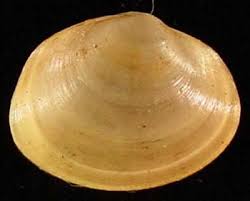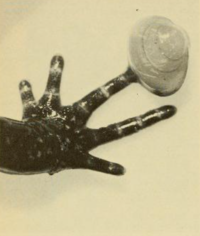Fingernail Clam: Difference between revisions
No edit summary |
No edit summary |
||
| Line 9: | Line 9: | ||
Order: ''Sphaeriida'' | Order: ''Sphaeriida'' | ||
[[File: | [[File: Download (2).jpg|522px|thumb|left| Figure 1- Fingernal Clam ]] | ||
=='''Introduction'''== | =='''Introduction'''== | ||
Fingernail clams (Pisidium moitessierianum) are part of a family called [[Sphaeriidae]], which includes many similar small freshwater clams. Fingernail clams are also referred to as Pill Clams or Pea Clams. These clams are easily identified. They are less than half an inch wide and can range from dark tan to pale yellow.[3] Their shells mirror each other and are hinged at the rear; the mollusk's growth rings are also usually quite prominent.[1] | Fingernail clams (Pisidium moitessierianum) are part of a family called [[Sphaeriidae]], which includes many similar small freshwater clams. Fingernail clams are also referred to as Pill Clams or Pea Clams. These clams are easily identified. They are less than half an inch wide and can range from dark tan to pale yellow.[3] Their shells mirror each other and are hinged at the rear; the mollusk's growth rings are also usually quite prominent.[1] | ||
=='''Range & Habitat'''== | =='''Range & Habitat'''== | ||
Fingernail Clams live along the bottom or sides of water bodies like lakes, ponds, and vernal pools. They can use their foot to traverse their way through leaf litter and sediment. This species is native to Europe but has been introduced to northeastern North America. They feed on suspended material in the water column by filtering it through siphons. They prefer clean well well-oxygenated water. Fingernail Clams are also hermaphroditic and only live for 1-2 years. They have internal fertilization and brood their young, meaning the larvae partially develop on the parent before being released.[2] | Fingernail Clams live along the bottom or sides of water bodies like lakes, ponds, and [[Vernal Pools|vernal pools]]. They can use their foot to traverse their way through leaf litter and sediment. This species is native to Europe but has been introduced to northeastern North America. They feed on suspended material in the water column by filtering it through siphons. They prefer clean well well-oxygenated water. Fingernail Clams are also hermaphroditic and only live for 1-2 years. They have internal fertilization and brood their young, meaning the larvae partially develop on the parent before being released.[2] | ||
[[File: 200px-Clam on a blue spotted salamander.png|522px|thumb|right| Figure 2- Fingernal Clam attached to Blue Spotted Salamander Toe]] | [[File: 200px-Clam on a blue spotted salamander.png|522px|thumb|right| Figure 2- Fingernal Clam attached to Blue Spotted Salamander Toe]] | ||
Revision as of 18:32, 18 April 2025
Classification
Kingdom: Plantae
Phylum: Mollusca
Class: Bivalvia
Order: Sphaeriida

Introduction
Fingernail clams (Pisidium moitessierianum) are part of a family called Sphaeriidae, which includes many similar small freshwater clams. Fingernail clams are also referred to as Pill Clams or Pea Clams. These clams are easily identified. They are less than half an inch wide and can range from dark tan to pale yellow.[3] Their shells mirror each other and are hinged at the rear; the mollusk's growth rings are also usually quite prominent.[1]
Range & Habitat
Fingernail Clams live along the bottom or sides of water bodies like lakes, ponds, and vernal pools. They can use their foot to traverse their way through leaf litter and sediment. This species is native to Europe but has been introduced to northeastern North America. They feed on suspended material in the water column by filtering it through siphons. They prefer clean well well-oxygenated water. Fingernail Clams are also hermaphroditic and only live for 1-2 years. They have internal fertilization and brood their young, meaning the larvae partially develop on the parent before being released.[2]

Name Origen
Though most fingernails claims got their name because they are commonly seen attaching themselves to the toes of amphibians, this is not the case. Fingernail Clams got their name because they are the size of a fingernail and resemble human fingernails in shape and color.
Refrences
[1] Association, M. N. 2021, July 27. Species Spotlight: Fingernail Clam.
[2]European fingernail clam (Sphaerium corneum) - Species Profile. (n.d.). . https://nas.er.usgs.gov/queries/FactSheet.aspx?speciesID=131.
[3]Fingernail Clams | Missouri Department of Conservation. (n.d.). . https://mdc.mo.gov/discover-nature/field-guide/fingernail-clams.